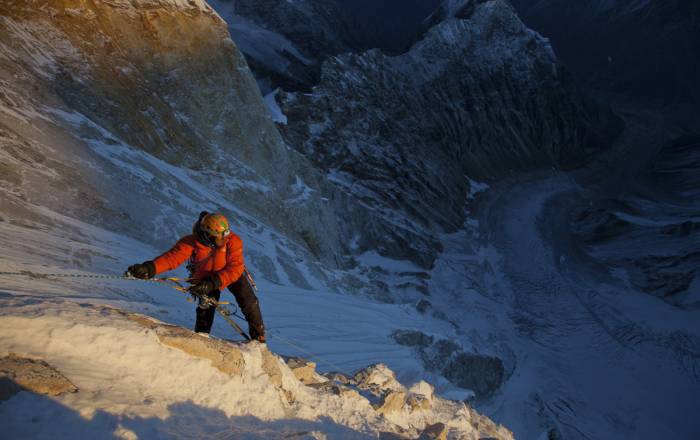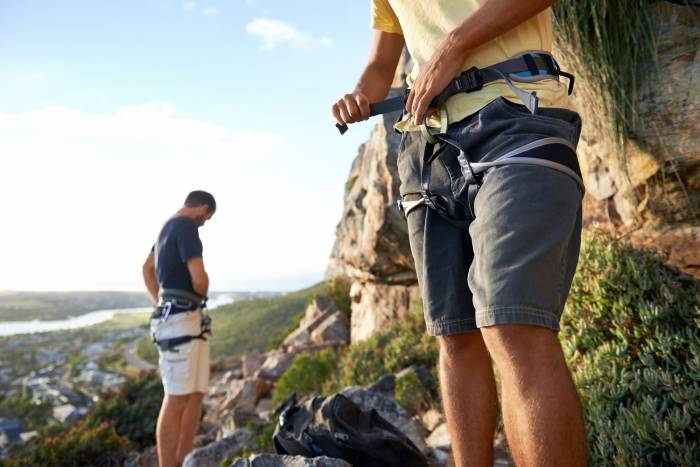[leadin]Jimmy Chin is a very, very busy guy.[/leadin]

“Yeah…no, yeah, let’s do it,” he said when I connected with him via phone after a few months of back-and-forth. Chin, 42, of Jackson, Wyoming, sounded harried. This wasn’t the best time for an interview – he had just finished a different call, and was driving from the Los Angeles airport into the city for another project. It was Friday at 4:30 p.m. on the west coast, and he was very much in the throes of the workweek.
The thing is, no time is a great time to interview Chin. He is a professional athlete – a climber and skier, mostly – for The North Face; but he is also a professional photographer and filmmaker. Those are two jobs that, by themselves, require a huge time commitment and have variable schedules with odd hours and long days, weeks, and even months, away from home.
Chin does both of them simultaneously, and sometimes they overlap: in 2011, Chin, with Conrad Anker and Renan Ozturk, made the first ascent of Mount Meru’s Shark Fin, a high-alpine big wall in northern India; the climb was documented in the 2015 film Meru, which Chin directed, produced, and (with Ozturk’s help) shot.
So, yes – he’s busy. And that was exactly what I wanted to talk to him about: how he balances dual ambitions as an athlete and a content-producer; his tricks for shooting in expedition conditions; and his roots in Minnesota, where GearJunkie is based.

GearJunkie: First off – to put it simply – how do you balance being a top-flight climber and athlete with being a top-flight, sought-after photographer and filmmaker? Do you identify yourself more as an athlete or a creator?
Jimmy Chin: It definitely fluctuates. There are a lot of different aspirations and inspirations I have, and some of them are more physically- and athletically-based, while some are more intellectually and creatively-based. Usually, they’re tied closely together, so often times it’s both.
I do still love the days in the mountains or out in the ocean, where it’s just a big day of skiing, for example, and I don’t even think about shooting a photo. There are also projects that are just shooting-based and creatively-based and all you’re thinking about is creating an image or capturing footage. It spans that whole spectrum, which I think is cool.
To that end, do you ever feel your photography work pulls you away from your climbing pursuits, or vice-versa?
They can work symbiotically, but I can get pulled in a lot of different directions. In any month, I have personal athletic objectives, but also a big photo shoot, and maybe a motion shoot on another production. There’s always a lot going on – I shoot commercial work, and editorial work, and sometimes just for fun. There’s also the business side; since all of these careers are businesses that require management. There’s always a lot of bouncing between these different aspects of my world.
What unique challenges do you face when you combine the two – when you’re on a major expedition but you’re also shooting or filming it?
I’ll put it this way: when you go on a climb, there are a thousand things to think about. When you go on a shoot, there are a thousand things to think about. When you do both, there are two thousand things to think about. You’re managing more equipment and thinking not just about the risks and objective hazards of climbing, but also about high-angle shooting and equipment and everything else.
Is the desire not to hold up a climb or expedition because of your photo/film equipment, or because you’re trying to get good footage, ever a source of stress?
It depends what kind of shoot it is. If it’s commercial, you’re more focused on going out to get good footage. That’s the whole point. But if it’s a big climb and you’re shooting editorially, your shooting definitely shouldn’t hold up the climbing.
How, then, do you keep from getting weighed down or otherwise slowed by the extra bulk of your cameras?
I usually go with a really stripped-down system for the weight. You’re already managing a lot of tasks so I try to keep it pretty simple. It’s also about being really organized with your systems, and really familiar with them so you can be efficient. So much of shooting on expeditions and difficult climbs is about efficiency.
What does your stripped-down system include? What’s the minimum photo equipment you’d take on a climb?
It depends. If it’s a bigger climb, I’d have just one body and one zoom lens. If it’s a bigger sort of commercial shoot, where you’re setting up shots, then you can bring a bit more equipment.
Do the elements – cold, rain, lack of power – add an extra challenge to protecting and maintaining your photo equipment?
With shooting, the same as if you were going on any expedition or climb, you try to avoid storms and prepare and plan to set yourself up for success. Keeping a stripped-down system helps. And I’ve used all kinds of recharging systems, but most recently have been using Goal Zero.
What technology doesn’t yet exist that would make your job easier? If you could invent one piece of technology that would help, what would it be?
Smaller and smaller camera systems with higher and higher resolutions are being invented all the time, whether that’s a photo or motion camera. The ultimate camera for me would be super lightweight with incredible optics, the optics of some of the best lenses out there. Like, with f/1.2L, you can shoot beautiful raw footage as well as just really high-resolution imagery. Basically, any system that became lighter and smaller, with great optics, would be great for me.
As a media producer, you’re at an interesting intersection of big productions (Meru film), social media (Instagram), and brand-supported media projects (The North Face). Sum up the state of adventure photography right now. Where is it all going?
Even in the last five years, the proliferation of cameras and social media has kind of democratized photography. There’s tons of talent out there, and I think seeing all this great imagery really elevates peoples’ game. There’s so much beautiful, incredible work out there that it pushes everybody, and it’s a great thing, that people who are really talented and savvy with social media can create their own careers.
But I think the hard part is – and has always been – the storytelling. How do you put together a series of images, how do you put together this great footage you’ve captured, and what are you saying with it, and how? The complexity of thought behind the work still differentiates photographers who shoot great images from those who are great at storytelling. There’s still a depth and complexity that great photographers and filmmakers have when they think about and approach a subject.
GearJunkie is based in Minneapolis, and you grew up in Mankato, Minnesota – about an hour south – and attended Carleton College in Northfield, not far from the Twin Cities. Tell us about your upbringing here – what shaped you into a skier and climber?
There was this teeny little hill behind my house called Mount Kato, and that’s where I fell in love with skiing, even though it was always arctic and basically skiing on ice. I just loved being out there – the speed, the freedom of it. Then I really fell in love with climbing in college. I climbed on some of the buildings at Carleton, but also spent a lot of time out in Joshua Tree National Park. I’ve climbed up in Palisade Head [on Minnesota’s north shore of Lake Superior], and it’s a stunning place, no matter how many places in the world you’ve climbed.
I fell in love with the cerebral part of climbing, then the stories and history, the iconic people – Conrad [Anker], Peter Croft, Alex Lowe – and how they could take climbing to all these remote places I wanted to see. I thought Minnesota was a great place to grow up, and is beautiful in its own way, but for some reason, it made me want to explore the rest of the world, too.
It sounds like that manifested itself in college. How often did you leave campus for Joshua Tree?
All of my breaks, especially in the summer, I would spend a lot of time driving west to Joshua Tree, as well as to Yosemite, Smith Rock, Rocky Mountain National Park, and so on. I loved living on the road, and I think that’s a unique experience in the States, to just drive around the west and never know exactly where you were going, just following the seasons. And I got connected with the climbing community – I ended up seeing people in all these places, getting to know them, making friends with people who had this shared passion for climbing and adventure. The people I ran into over and over again had that same makeup of wanting to live free, always excited and motivated to go on an adventure.
There’s a lot of self-motivation in climbing; you only do it because you love it. There aren’t official restrictions to it outside sport climbing in competition. When you’re out on the road and pushing yourself, there’s no one pushing you to do that except yourself, because it inspires you. There’s purpose and meaning behind that. Everyone tries to find purpose in their lives, and climbing satisfies that for me.
–Follow Jimmy Chin on Instagram via @Jimmy_Chin.






